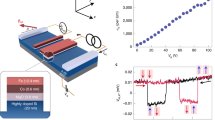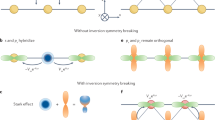Abstract
Spin–orbit coupling is a manifestation of special relativity. In the reference frame of a moving electron, electric fields transform into magnetic fields, which interact with the electron spin and lift the degeneracy of spin-up and spin-down states. In solid-state systems, the resulting spin–orbit fields are referred to as Dresselhaus and Rashba fields, depending on whether the electric fields originate from bulk or structure inversion asymmetry, respectively. Yet, it remains a challenge to determine the absolute value of both contributions in a single sample. Here, we show that both fields can be measured by optically monitoring the angular dependence of the electrons’ spin precession on their direction of motion with respect to the crystal lattice. Furthermore, we demonstrate spin resonance induced by the spin–orbit fields. We apply our method to GaAs/InGaAs quantum-well electrons, but it should be universally useful to characterize spin–orbit interactions in semiconductors, and therefore could facilitate the design of spintronic devices.
This is a preview of subscription content, access via your institution
Access options
Subscribe to this journal
Receive 12 print issues and online access
$209.00 per year
only $17.42 per issue
Buy this article
- Purchase on Springer Link
- Instant access to full article PDF
Prices may be subject to local taxes which are calculated during checkout




Similar content being viewed by others
References
Dresselhaus, G. Spin–orbit coupling effects in zinc blende structures. Phys. Rev. 100, 580–586 (1955).
Bychkov, Y. A. & Rashba, E. I. Oscillatory effects and the magnetic susceptibility of carriers in inversion layers. J. Phys. C 17, 6039–6045 (1984).
Winkler, R. Spin–Orbit Coupling Effects in Two-Dimensional Electron and Hole Systems (Springer Tracts in Modern Physics, Vol. 191/2003, Springer, Berlin, 2003).
Datta, S. & Das, B. Electronic analog of the electro-optic modulator. Appl. Phys. Lett. 56, 665–667 (1990).
Schliemann, J., Egues, J. C. & Loss, D. Nonballistic spin-field-effect transistor. Phys. Rev. Lett. 90, 146801 (2003).
D’Yakonov, M. I. & Perel’, V. I. Spin relaxation of conduction electrons in noncentrosymmetric semiconductors. Sov. Phys. Solid State 13, 3023–3026 (1971).
Lommer, G., Malcher, F. & Rossler, U. Spin splitting in semiconductor heterostructures for B→0. Phys. Rev. Lett. 60, 728–731 (1988).
Luo, J., Munekata, H., Fang, F. F. & Stiles, P. J. Effects of inversion asymmetry on electron energy band structures in GaSb/InAs/GaSb quantum wells. Phys. Rev. B 41, 7685–7693 (1990).
Nitta, J., Akazaki, T., Takayanagi, H. & Enoki, T. Gate control of spin–orbit interaction in an inverted In0.53Ga0.47As/In0.52Al0.48As heterostructure. Phys. Rev. Lett. 78, 1335–1338 (1997).
Schapers, T. et al. Effect of the heterointerface on the spin splitting in modulation doped InxGa1−xAs/InP quantum wells for B→0. J. Appl. Phys. 83, 4324–4333 (1998).
Das, B. et al. Evidence for spin splitting in InxGa1−xAs/In0.52Al0.48As heterostructures as B→0. Phys. Rev. B 39, 1411–1414 (1989).
Engels, G., Lange, J., Schäpers, T. & Lüth, H. Experimental and theoretical approach to spin splitting in modulation-doped InxGa1−xAs/InP quantum wells for B→0. Phys. Rev. B 55, R1958–R1961 (1997).
Hu, C.-M. et al. Zero-field spin splitting in an inverted In0.53Ga0.47As/In0.52Al0.48As heterostructure: Band nonparabolicity influence and the subband dependence. Phys. Rev. B 60, 7736–7739 (1999).
Pfeffer, P. & Zawadzki, W. Spin splitting of conduction subbands in III–V heterostructures due to inversion asymmetry. Phys. Rev. B 59, R5312–R5315 (1999).
Brosig, S. et al. Zero-field spin splitting in InAs-AlSb quantum wells revisited. Phys. Rev. B 60, R13989–R13992 (1999).
Koga, T., Nitta, J., Akazaki, T. & Takayanagi, H. Rashba spin–orbit coupling probed by the weak antilocalization analysis in InAlAs/InGaAs/InAlAs quantum wells as a function of quantum well asymmetry. Phys. Rev. Lett. 89, 046801 (2002).
Ganichev, S. D. et al. Experimental separation of Rashba and Dresselhaus spin splittings in semiconductor quantum wells. Phys. Rev. Lett. 92, 256601 (2004).
Miller, J. B. et al. Gate-controlled spin–orbit quantum interference effects in lateral transport. Phys. Rev. Lett. 90, 076807 (2003).
Grundler, D. Large Rashba splitting in InAs quantum wells due to electron wave function penetration into the barrier layers. Phys. Rev. Lett. 84, 6074–6077 (2000).
Heida, J. P., van Wees, B. J., Kuipers, J. J., Klapwijk, T. M. & Borghs, G. Spin–orbit interaction in a two-dimensional electron gas in a InAs/AlSb quantum well with gate-controlled electron density. Phys. Rev. B 57, 11911–11914 (1998).
Matsuyama, T., Kürsten, R., Meißner, C. & Merkt, U. Rashba spin splitting in inversion layers on p-type bulk InAs. Phys. Rev. B 61, 15588–15591 (2000).
Kalevich, V. & Korenev, V. Effect of electric field on the optical orientation of 2D electrons. JETP Lett. 52, 230–235 (1990).
Kato, Y., Myers, R. C., Gossard, A. C. & Awschalom, D. D. Coherent spin manipulation without magnetic fields in strained semiconductors. Nature 427, 50–53 (2004).
Crooker, S. A. & Smith, D. L. Imaging spin flows in semiconductors subject to electric, magnetic, and strain fields. Phys. Rev. Lett. 94, 236601 (2005).
Kato, Y. K., Myers, R. C., Gossard, A. C. & Awschalom, D. D. Current-induced spin polarization in strained semiconductors. Phys. Rev. Lett. 93, 176601 (2004).
Engel, H.-A., Rashba, E. I. & Halperin, B. I. Out-of-plane spin polarization from in-plane electric and magnetic fields. Phys. Rev. Lett. 98, 036602 (2007).
Ganichev, S. & Prettl, W. Spin photocurrents in quantum wells. J. Phys. Condens. Matter 15, R935–R983 (2003).
Duckheim, M. & Loss, D. Electric-dipole-induced spin resonance in disordered semiconductors. Nature Phys. 2, 195–199 (2006).
Bloch, F. & Siegert, A. Magnetic resonance for nonrotating fields. Phys. Rev. 57, 522–527 (1940).
Crooker, S. A., Awschalom, D. D. & Samarth, N. Time-resolved faraday rotation spectroscopy of spin dynamics in digital magnetic heterostructures. IEEE J. Sel. Top. Quantum Electron. 1, 1082–1092 (1995).
Meier, L., Salis, G., Ellenberger, C., Ensslin, K. & Gini, E. Stray-field-induced modification of coherent spin dynamics. Appl. Phys. Lett. 88, 172501 (2006).
Kikkawa, J. M. & Awschalom, D. D. Resonant spin amplification in n-type GaAs. Phys. Rev. Lett. 80, 4313–4316 (1998).
Acknowledgements
The authors wish to acknowledge R. Leturcq for help with sample preparation and M. Duckheim, D. Loss, R. Allenspach and T. Ihn for discussions. This work was supported by the Swiss National Science Foundation (NCCR Nanoscale Science).
Author information
Authors and Affiliations
Contributions
L.M. carried out the experiments and analysed the data in close collaboration with G.S. Samples were fabricated by L.M. and I.S., and grown by E.G. (samples 1 and 2) and S.S. (sample 3). K.E. initiated the collaboration and supported the project in discussions.
Corresponding authors
Ethics declarations
Competing interests
The authors declare no competing financial interests.
Rights and permissions
About this article
Cite this article
Meier, L., Salis, G., Shorubalko, I. et al. Measurement of Rashba and Dresselhaus spin–orbit magnetic fields. Nature Phys 3, 650–654 (2007). https://doi.org/10.1038/nphys675
Received:
Accepted:
Published:
Issue Date:
DOI: https://doi.org/10.1038/nphys675
This article is cited by
-
Optimal operation points for ultrafast, highly coherent Ge hole spin-orbit qubits
npj Quantum Information (2021)
-
Interplay of spin–orbit coupling and Coulomb interaction in ZnO-based electron system
Nature Communications (2021)
-
Effective Landé factors for an electrostatically defined quantum point contact in silicene
Scientific Reports (2021)
-
Spin-charge interconversion in heterostructures based on group-IV semiconductors
La Rivista del Nuovo Cimento (2020)
-
Spin-momentum locked spin manipulation in a two-dimensional Rashba system
Scientific Reports (2019)



